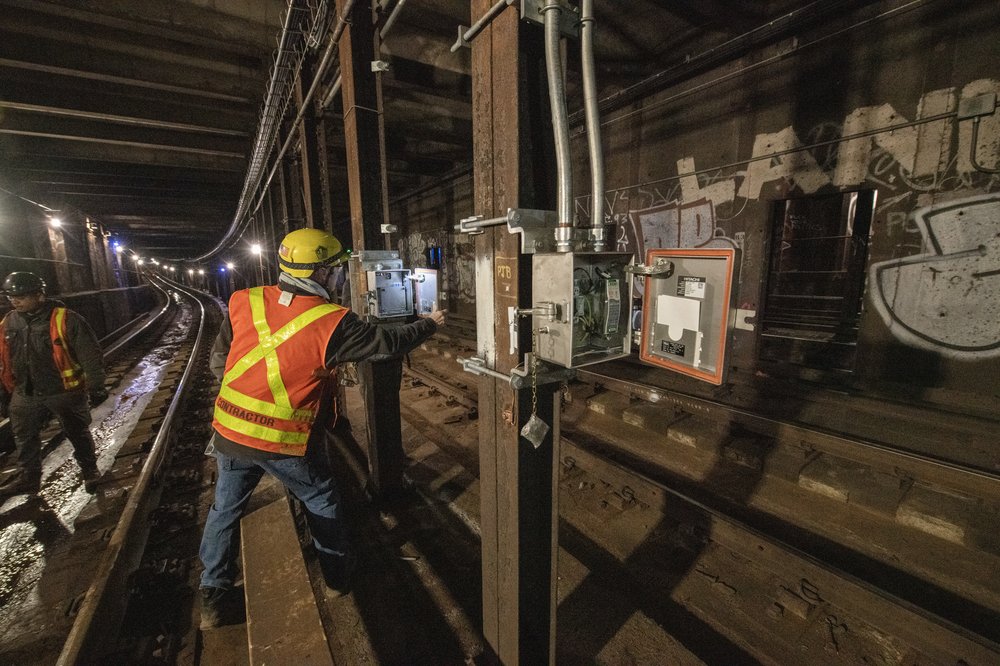Every NYC subway signal upgrade is far behind schedule, MTA consultant says
July 28, 2025, 4:48 p.m.
MTA Chair Janno Lieber regularly says he delivers projects "on time and on budget." The agency's push to upgrade aging subway equipment is neither.

The MTA’s multi-billion-dollar push to upgrade the subway’s aging signal system is years behind schedule and millions over budget, according to a report by one of the agency’s consultants on Monday.
The MTA is currently working to modernize signals on four stretches of the system. All of those projects now face extensive delays, ranging from nine months to three years, according to an independent engineering firm that delivered the report to MTA board members.
Two of the projects are over budget. The report also notes the MTA’s effort to upgrade signals on portions of subways in Queens wrapped up in March, four years later than its initial schedule.
For decades, transit officials have billed modern subway signals as a silver bullet to improve service and reduce delays. Much of the system relies on 1930s-era technology to direct trains across the city, but a newer system, known as communications-based train control, allows for trains to communicate with each other, and travel faster and closer together.
The engineering consultant estimated signal upgrades on the F line in southern Brooklyn will be completed in September, three years later than originally forecast. Similar work on the A, C and E lines beneath Eighth Avenue in Manhattan won’t be done until October 2027, more than two years later than planned, and upgrades on the F train in eastern Queens won’t wrap until March 2028, which is more than a year past the MTA’s original schedule, according to the report.
The report also found the MTA’s work to upgrade signals on the G train — which led to entire stretches of the line to shut down for much of last summer — is also severely delayed. The MTA’s consultant estimates the entire line won’t wrap until July 2029, two years later than planned.
MTA officials during a public meeting Monday blamed the agency’s contractors and a lack of engineering expertise for the delays.
Jamie Torres-Springer, the agency’s construction chief, said the chief problem with the G line is that the modern signal systems require 5G technology, but the transponders on the MTA’s newest subway cars use obsolete 4G technology.
”It's like having a cell phone from the year 2000. We all know that we can't use that anymore,” Torres-Springer said Monday. “So we're upgrading all of the technology over time, but we made sure that we're getting it first on the G train.”
Springer said the Federal Communications Commission still needs to approve the installation of the 5G equipment.
MTA officials also said there aren’t enough qualified engineers to complete the signal work. Gregor Sulmont, the MTA official overseeing the signal work, noted the MTA’s project to upgrade signals in eastern Queens will also rebuild the line’s old signal equipment, but he said there aren’t enough people who know how to work on the older equipment.
“ We are working with the contractor to train up and qualify additional engineers to get the project across the finish line,” he said.
Sulmont blamed the MTA’s contractor for delays to the signal project on the A, C and E tracks in Manhattan. He said the company incorrectly installed equipment on the line.
The delays come as the MTA gears up to launch even more signal upgrades. The agency’s new five-year construction plan approved this year allocates another $5.4 billion toward upgrading the systems.
Much of the MTA’s push to modernize its subway signals began under former NYC Transit President Andy Byford, who in 2018 published a long-term plan to rapidly upgrade the system and hired Pete Tomlin, a world-renowned train signal expert, to manage the work. Byford — who gained the nickname “Train Daddy” during his two-year tenure at the MTA — never got to oversee those projects.
In 2019, a state-mandated reorganization of the MTA under then-Gov. Andrew Cuomo put the agency’s construction department in charge of all major subway work. The department at the time was led by Janno Lieber, who in 2021 was elevated to MTA chair.
Byford and Tomlin both resigned following the move. Lieber has since repeatedly said he has a record of completing construction work “on time and on budget.”
Driving blind: NYC subways steered by 1930s tech, paper maps and a lot of hope